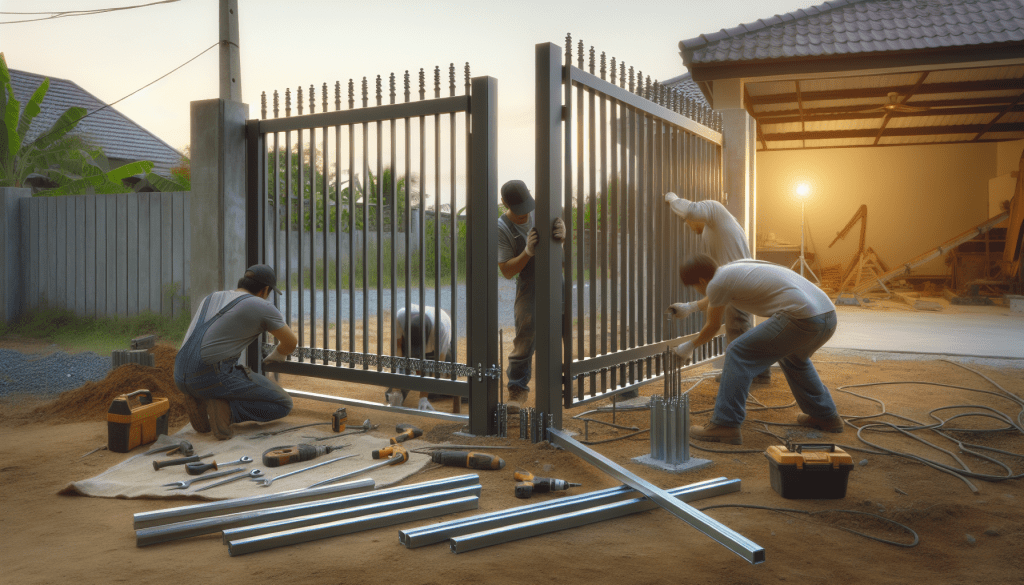Can heavy-duty gates truly fortify a property as claimed? This article examines how well heavy-duty gates protect your property, particularly in terms of durability, security, and installation. We also take a look at how the quality of construction can impact all of those factors. You can expect to gain a solid understanding of their design, maintenance needs, and whether a heavy-duty gate is worth the additional cost.
High-Quality Heavy-Duty Gate Installation
Key Takeaways
- Heavy duty gates are constructed with high-quality materials like steel.
- Gates that are considered heavy-duty are designed to be resilient and durable, offering long-term security by guarding against unauthorized access and potential damage.
- The installation of heavy-duty gates is a complex task that requires precision, specific tools and safety equipment. Ongoing maintenance is also necessary to ensure long-lasting operation and functionality.
- Heavy-duty gates combine strength with aesthetics, offering customization options like pickets and powder coat finishes.
- A heavy-duty gate can come equipped with advanced access control features to improve user convenience and security.
A Closer Look at What Makes Heavy-Duty Gates Different
When heavy-duty gates are built right they’re formidable structures of exceptional strength and durability that ensure security. Crafted with high-quality materials like iron and steel, these gates protect properties from unauthorized access, theft, and damage. Their sturdy construction paired with premium materials creates physical barriers that can effectively safeguard vulnerable areas.
The strength of these gates is second to none. Their ability to bear significant weight, along with the inclusion of heavy-duty gate hinges and extra reinforcement like tubing, ensures their durability over time. However, it’s vital that the builder knows how to construct these gates for them to genuinely live up to their reputation.
What It Takes to Install Your Heavy-Duty Gate

Installing a heavy-duty gate requires meticulous precision and a firm understanding of the materials you’re working with. It can also entail accurate wiring and the integration of safety systems.
Working with such materials can be risky. The tools required for the job can also be dangerous. Building a heavy-duty gate requires more than a power drill and wrenches. It can include power saws and welding equipment. Safety gear such as gloves and goggles should be worn at all times.
Analyzing the Craftsmanship of Heavy-Duty Gates
The superior craftsmanship of heavy-duty gates is evident in their strength and durability. Let’s explore the materials and design features that enhance the architectural integrity of these gates.
Architectural Integrity – Materials and Durability
Heavy-duty gates are usually built using steel due to its inherent strength and durability, especially in crucial components like hinges. They may also be combined with wood materials like western red cedar or mahogany. Aluminum gates offer strength while being lighter, and materials like vinyl are also recognized for their durability. These latter options can also be reinforced.
The longevity of heavy-duty gates is impressive. Steel heavy-duty gates, such as chain gates, typically have a projected lifespan of over 25 years. Iron gates, when appropriately powder coated, can last for approximately 20 years.
User-Friendly Operation – Ease of Access and Control
Heavy-duty gates can come equipped with various access control features that prevent unauthorized access and potential animal abuse in properties with livestock, such as cattle. These features provide a seamless and efficient gate operation, utilizing advanced gate operator technology.
Enhanced features include:
- Safety sensors
- Keypads
- Card readers
- Biometric systems
- Remote operation capabilities
There are also radiofrequency ID (RFID) gate access control systems and Automatic Number Plate Recognition (ANPR) gate access control, which is convenient for multi unit housing complexes.
Aesthetic Considerations – Does Strength Compromise the Style of Heavy-Duty Gates?
Heavy-duty gates do not compromise style for strength. There are many custom features that can be incorporated for aesthetic purposes while maintaining the gate’s strength. The options include:
- Pickets
- Ornamental finials
- Scrollwork
- Custom logos
- Lettering
Just because a gate is made of metal doesn’t mean it has to be gray or black. Heavy-duty gates are offered in a variety of colors and finishes, such as powder coat finishes.
Heavy-duty gates can also seamlessly integrate into various architectural styles, including modern, traditional, or transitional. They can be designed to complement the property’s aesthetic exactly, ensuring a cohesive appearance.
Putting Heavy-Duty Gates to the Test
Having evaluated the features, craftsmanship, and materials used in the construction of heavy-duty gates, it’s time to test their performance under real-world conditions, including shipping materials.
Real-World Resilience – Stress Testing the Gates
There are stress testing techniques that are used to gauge the durability of heavy-duty gates. Usually the process entails exposing a type of gate or gate material to loads that surpass regular usage patterns. This allows experts to evaluate their robustness and longevity. There’s also something called the gudgeon stress test, where a load is applied to the gudgeon pin to assess its strength and integrity. Other methods like visual inspection, ultrasonic testing, and magnetic particle inspection may be utilized.
Key resilience factors that are being tested include:
- The ability to support building functions under severe lateral load effects.
- The connections and security of various types of fittings.
- The ability to withstand the elements and maintain structural integrity even in challenging environments.
Maintenance and Longevity – Maintaining the Strength of Your Heavy-Duty Fence
With proper maintenance, the lifespan of a heavy-duty gate typically extends beyond 10-15 years. Regular maintenance for these gates encompasses:
- Cleaning
- Lubrication
- Inspection
- Tightening
- Electrical upkeep
Smooth operation is another maintenance measure for heavy-duty gates. Applying high-quality grease to lubricate sealed bearing hinges ensures smooth opening and closing.
Even with good maintenance, well-built gates can show signs of strain with time. Issues like stress cracks, inadequately welded joints, and slag inclusion might occur in heavy-duty gates after prolonged usage. Other failure points could include:
- Damage from substantial impacts
- Power interruptions
- Misalignment
- Sensor malfunctions
- Risks related to insufficiently safeguarded and maintained sliding gate systems.
Over five years, the standard maintenance expenses for a heavy-duty gate can be in the thousands, a factor to consider in the overall investment evaluation.
In Closing – Is a Heavy-Duty Gate Worth the Investment?
Heavy-duty gates offer an unparalleled combination of security, durability, and aesthetic appeal. Their robust construction, high-quality materials, and user-friendly operation features make them a formidable first line of defense for any property. Despite the initial investment and maintenance costs, their long-term benefits can outweigh the expenses.
Compared to manual gates made of standard materials, heavy-duty gates offer superior strength and durability, with enhanced performance and security capabilities that are often coupled with the convenience of automatic operations. A heavy-duty gate can yield long-term financial advantages through improved security and creating physical barriers. It’s a substantial investment for commercial and residential properties alike, but one that could be worth it.
In addition to the installation, there are standard maintenance costs for a heavy-duty gate. Maintenance can be as much as $8200 over the course of five years. These expenses should be factored into the overall investment evaluation. On a positive note, properties with heavy-duty gates may be eligible for insurance discounts because these gates provide an exemplary security layer.
In conclusion, despite the seemingly high upfront cost and maintenance expenses, the enhanced security, durability, and potential insurance discounts make heavy-duty gates a commendable investment.
Frequently Asked Questions
What are the primary characteristics of heavy-duty gates?
Heavy-duty gates are characterized by their ability to support significant weight, the use of extremely durable gate hinges, and high-quality materials like tubing for prolonged durability. This ensures reliable and long-lasting performance while providing maximum strength to fortify entrances, driveways and properties.
What materials are used in the construction of heavy-duty gates?
Heavy-duty gates are commonly constructed using steel for their robust strength and durability. Gate builders may also incorporate stainless steel, iron, aluminum and visually appealing materials like western red cedar or mahogany.
What is the typical lifespan of a heavy-duty gate?
A heavy-duty gate typically lasts 10-15 years or more with proper maintenance.
How are heavy-duty gates tested for stress?
Heavy-duty gates are tested for stress by subjecting them to heavy loads that exceed standard usage patterns. This helps manufacturers and contractors evaluate their robustness, availability, and error-handling capabilities.
Are heavy-duty gates a worthwhile investment?
Heavy-duty gates can be a good investment due to their long-term benefits in security, durability, and potential insurance discounts.




